Text
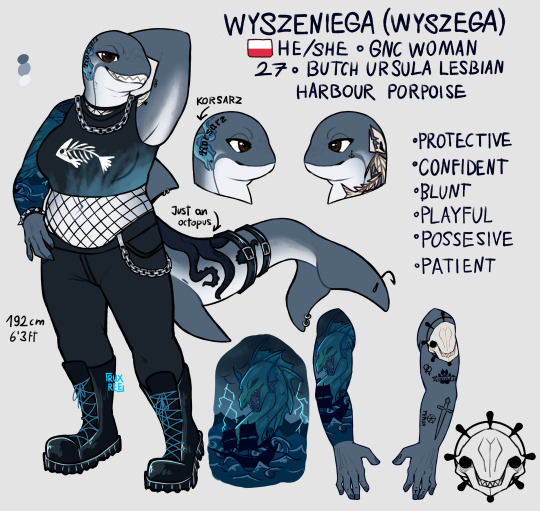
Meet Wyszega!! (put it in google translate to hear the pronunciation)
Kalina is his girlfriend!
th page
#art#anthro#digital art#artwork#edgy#furry#lesbian#butch lesbian#harbor porpoise#aquatic furry#oc#original character#polish#anthropomorphic#furryart#furry sfw#cetacean#cetacean furry#anthro cetacean#oc:Wyszega#my art
380 notes
·
View notes
Text
100 notes
·
View notes
Text
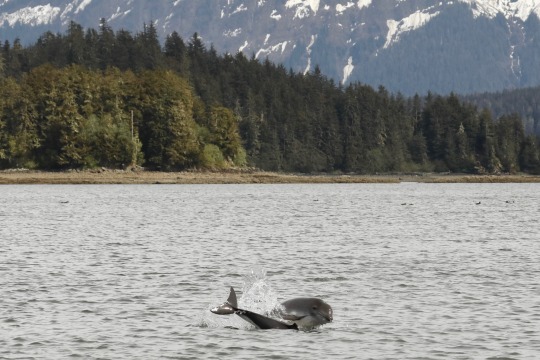
Harbor Porpoises at Auke Bay, Juneau
149 notes
·
View notes
Text
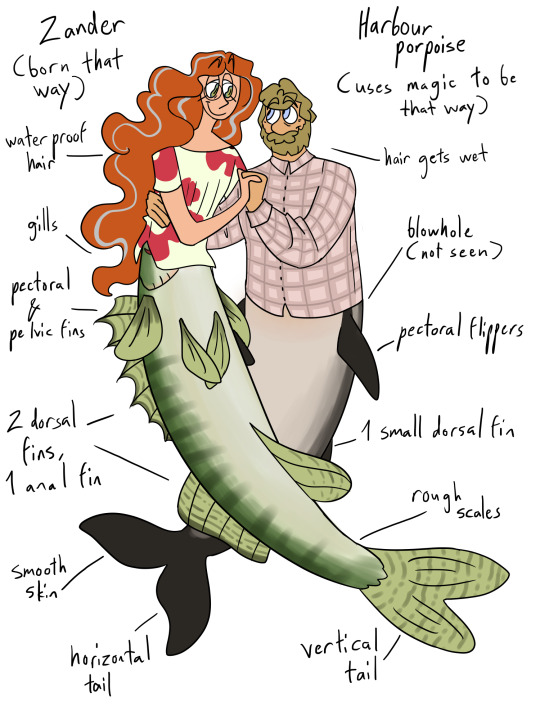
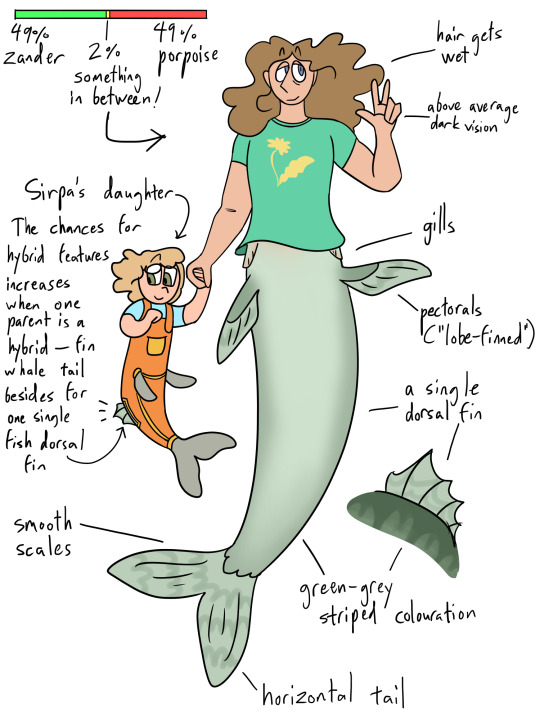
More mermaid things! I mentioned in the merfolk overview post that mermaids can use magic to become two-legged, other humans can do the same but in reverse! The spell isn't the exact same sort that created merfolk so long ago, but it does the job quite handily. Normal two-legged humans tend to gain an aquatic mammal lower body if they don't have other kinds of merfolk in their family.
In my previous art post I introduced Sirpa, who is a zander-harvour porpoise hybrid, a rare feature in half-animal people overall. Above we have Sirpa's parents, and then the mishmash of features that Sirpa inherited from them. Plus Sirpa's daughter who inherited one (1) teeny tiny fin!
#sirpa's parents' names are annika and kari lavaste (lavaste means a prop or a scenery flat.. because. the parents arent main characters)#sirpa's daughter's name meanwhile is liisa :) sirpa changed her surname so her and her daughter's surname is kartanen#dont tell me i didnt slay that zander tail!!#merfolk#mermaid#merfolk lore#zander#harbor porpoise#harbour porpoise#porpoise#art#my art#zander mermaid#porpoise mermaid#sirpaverse
44 notes
·
View notes
Note
Idk how often the rewritten clans would go near the ocean, but I imagine not enough to see things like orcas (who do occasionally show up around Britain)
So imagine, for whatever reason is needed, some cats go by the ocean and see this MASSIVE black fish move through the waves, and then realise there’s a whole POD of them 0.0
Idk, just think it would be a pretty fun idea!
What's more likely is that they'd see porpoises! Specifically harbor porpoises. Occasionally orcas and minke whales are seen from the coast of Wales, but the general area where I've put the Clans is close to a shallow part of the Irish Sea where these little guys are common,

[ID: A small gray dolphin-like creature leaps out of the water. It's called a Harbor Porpoise]
When they discover the ocean and settle in the Lake territory, the Clans visit the beach once a year to collect salt for medicinal and culinary purposes. It's not too far-fetched they'd see one.
Maybe to you and me who are spoiled by the knowledge of big whales it would seem unimpressive, but this is BY FAR the largest “fish” they’d ever seen. It would be humbling and awe-inspiring to a little cat.
It would be cute if Midnight was able to see them so impressed by a porpoise, honestly. With her knowledge of megafauna, it would be endearing to see their reaction to something she’s long since stopped appreciating. Remind her of why she loves the cats so much.
#Btw a little mini-thing I'm trying to do is make the Lake territory more appealing#Because in canon MAN I hate the Lake map. Such a downgrade!!#So here I want to give it more things to make it interesting#New resources and landmarks and such#Clan culture#cetaceans#Harbor Porpoise
100 notes
·
View notes
Text

vaquita-memuco.jpg.860x0_q70_crop-smart
4 notes
·
View notes
Text
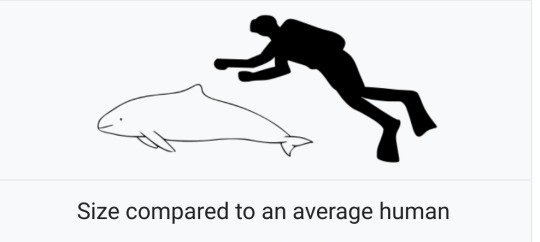
Please observe Wikipedia's image for the size of a harbor porpoise.
[ID: a black-and-white line drawing of a harbor porpoise, alongside the solid black silhouette of a human in scuba gear. The porpoise is drawn with a vague happy smile. The human figure is behind and above the porpoise and appears to be reaching menacingly towards it. Caption beneath reads "Size compared to an average human." /end ID]
22 notes
·
View notes
Text
Harbor Porpoise Calf & Ensuing Necropsy | 7/25/23 & 8/17/23
My first solo carcass collection!
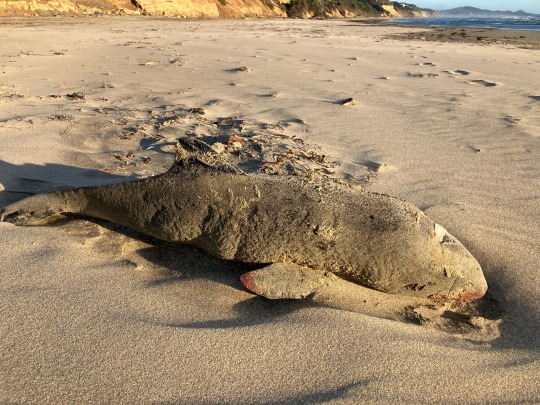
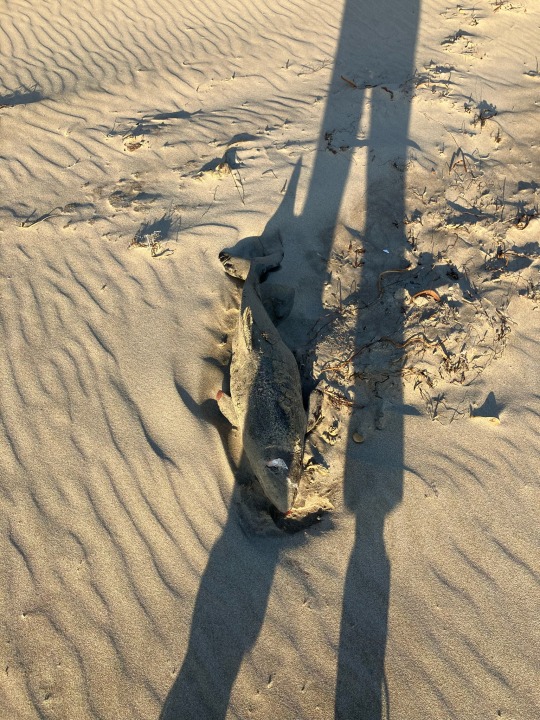
I got a call from a state park about someone who had reported “what looks like a dead dolphin or false killer whale”. The ranger had gone out to see for themselves but they told me that they couldn’t find it. I—knowing it was likely a harbor porpoise and not wanting to potentially miss a collectible carcass if there was a chance it was still there—drove the 16 minutes up to the beach and walked my ass about a mile up to the area where it was reported to have been spotted. I was doubting myself so I left the trash bag in my trunk and just brought gloves, but eventually I found it!
On the way, I saw a young dying pelican which was interesting but unfortunately we don’t deal with seabirds so there was nothing I could do to euthanize it.
I saw the little dorsal fin poking out of the sand in the distance and knew I’d found it. While I’d been walking I’d even seen the shoe prints of what must have been the ranger that went out to look for it going there and back, but I noticed that the prints stopped a decent distance away from the carcass, so I assume they misunderstood the location, but I’m glad I trusted my gut to travel out there.
Unfortunately, because I didn’t bring the trash bag up the beach with me, I had to carry this carcass by hand about a mile back. Due to it being, yknow, a sandy carcass, I didn’t really want to carry it back directly over my shoulder or against my chest, so I ended up having to walk back with it switching between being held raised a bit above my shoulder and held in front of me. It seriously worked my biceps…
I kept repeating “it’s for science” to myself as i walked back lmao
When I reached the beach access area there were still plenty of people around, and I felt like a criminal holding a dead body lmao. A group of (i counted) 12 kids of varying ages ran up to me to ask about it and it turned into a nice little educational moment. I got a few more questions as I carried it up the beach access but eventually I made it back to my car and put it in a bag and in the trunk.
Turns out the little guy was only 23 lbs so… I guess the way you carry something seriously makes a big difference.
Notably, this guy was super fresh and didn’t even have baby teeth yet, so how in the world he had several tiny invertebrates in his stomach when he was supposed to only be drinking milk still is beyond me!
Necropsy Notes | 8/17/23
General Comments: Carcass previously frozen, neonate, vibrissae present; some pink foam in trachea; several small items in stomach—appeared to be invertebrates; most organs unremarkable.
Sex • M
Weight • 23 lbs
Snout to melon • 2.0 cm
Snout to angle of mouth • 8.5 cm
Snout to blow hole • 9.0 cm
Snout to center of eye • 11.5 cm
Snout to ant. Insertion of dorsal fin • 38.0 cm
Snout to dorsal fin tip • 48.5 cm
Snout to fluke notch • 86.0 cm
Snout to anterior insertion of flipper • 20.0 cm
Snout to center of genital aperture • 43.25 cm
Snout to center of anus • 58.0 cm
Flipper Length • 17.5 cm
Flipper width • 6.5 cm
Fluke width • 22.0 cm
Dorsal fin height • 6.0 cm
Girth:
Axillary: 51.0 cm
Maximum: 53.0 cm
Anal: 31.0 cm
Blubber thickness •
Dorsal: 1.25 cm
Lateral: 1.0 cm
Ventral: 1.5 cm
Tissues Collected
Blubber
Kidney
Liver
Blood
Colon with feces
Brain
Kidney for lepto pcr
Heart
Lung
Muscle
Stomach contents
Adrenal gland
Diaphragm
Esophagus
Heart
Intestine
Kidney
Liver
Lung
Pancreas
Skeletal muscle
Skin in ethanol
Stomach
Thymus
Thyroid
trachea
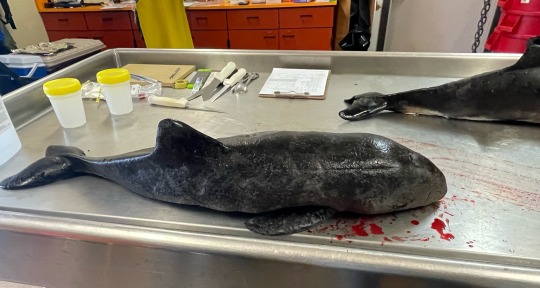
#marine biology#zoology#wildlife#biology#marine mammals#science#cetaceans#harbor porpoise#deceased#cw animal death#tw animal death
3 notes
·
View notes
Text

i think you're still a harbor porpoise. pacifica
0 notes
Text
in the latest episode of the Smithsonian Sidedoor podcast, the host goes to great lengths to describe how elusive and hard to spot river otters are, meanwhile I've seen them in a city park?? during broad daylight??? in a major metro area???? many times????? She even interviews an otter researcher who is like 'I've been studying them for years and still only actually seen one in person at the national zoo :('
like girl, move to seattle maybe? idk what to tell you, I've seen them while walking my dog or birding or even just getting coffee.
#????? do they live in an alternate reality where otters are not supremely unconcerned with human nonsense?#river otters in seattle harbor are like. less common than harbor seals but more common than sea lions or porpoises.#maybe just above orca-level common and more usual right in shore#solidly mid-tier level 'oh look! there goes a marine* mammal!'#*yes I know. they're called 'river' otters. they do happily venture into salt water though. they don't care what we named them lmao.
88 notes
·
View notes
Text
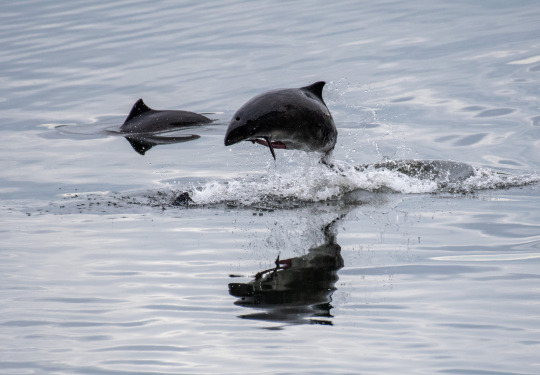
Eastern Pacific harbor porpoise Phocoena phocoena vomerina
Observed by dhardwick3, CC BY-NC
#Phocoena phocoena vomerina#eastern Pacific harbor porpoise#Cetacea#Phocoenidae#cetacean#porpoise#North America#United States#Washington#Pacific Ocean#Puget Sound#Quartermaster Harbor
64 notes
·
View notes
Text
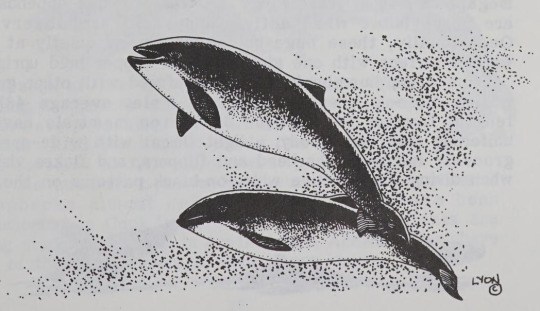
Marine Mammals of Southcentral Alaska: A Pocket Guide. Written by Janet R. Klein. Illustrated by Gary Lyon. 1984.
Internet Archive
145 notes
·
View notes
Text
i have seen literally so many wild marine mammals this month
22 notes
·
View notes
Text
I think I saw a harbor seal play fighting with a northern fur seal today
#I am a magnet for weird seal behavior#although I’m now quite sure the fucked up seal I saw a few weeks ago was a porpoise or dolphin that had something wrong with it#a seal with a gps tag on its head was hanging out with it though#anyway we saw splashing in the water and there were two seals slapping each other#they would pause and take a break and then go back to wrestling so I think they were playing#one looked like a harbor seal and the other was dark and had much longer flippers and a pointier little face like a fur seal
0 notes
Text

Majestic Breaching Intensifies
Photo of harbor porpoise by emma luck, twitter: emmaluck22
447 notes
·
View notes
Text

Most mosasaurs all had very similar body plans: they were streamlined scaly monitor-lizard-like marine reptiles with four rounded paddle-shaped flippers, and many of them also had large shark-like tail fins.
But Megapterygius wakayamaensis here seems to have been doing something a bit different.
Living towards the end of the Cretaceous, about 72 million years ago, in the waters covering what is now western Japan, this mosasaur was around the size of a modern orca, roughly 6m long (~20').
Unlike other known mosasaurs its flippers were huge, bigger than its own head and distinctively wing-shaped, with the back pair being larger than the front. This is an arrangement oddly reminiscent of the unrelated plesiosaurs, and may suggest a convergent sort of highly maneuverable "underwater flight" swimming ability – but unlike plesiosaurs Megapterygius also still had a powerful fluked tail, so how exactly all of its fins worked together is still unknown.
It's also the first mosasaur known to preserve potential evidence of a dorsal fin. Some of its back vertebrae show a change in orientation at the point where a fin base would be expected to be, closely resembling the vertebrae shape of cetaceans like the modern harbor porpoise.
—
NixIllustration.com | Tumblr | Patreon
#science illustration#paleontology#paleoart#palaeoblr#megapterygius#mosasauridae#mosasaur#squamata#lizard#lepidosauria#reptile#marine reptile#art#congrats to the artists who put speculative dorsal fins on their mosasaurs before this
601 notes
·
View notes